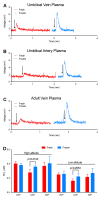Artifacts Introduced by Sample Handling in Chemiluminescence Assays of Nitric Oxide Metabolites
- PMID: 37759975
- PMCID: PMC10525973
- DOI: 10.3390/antiox12091672
Artifacts Introduced by Sample Handling in Chemiluminescence Assays of Nitric Oxide Metabolites
Abstract
We recently developed a combination of four chemiluminescence-based assays for selective detection of different nitric oxide (NO) metabolites, including nitrite, S-nitrosothiols (SNOs), heme-nitrosyl (heme-NO), and dinitrosyl iron complexes (DNICs). However, these NO species (NOx) may be under dynamic equilibria during sample handling, which affects the final determination made from the readout of assays. Using fetal and maternal sheep from low and high altitudes (300 and 3801 m, respectively) as models of different NOx levels and compositions, we tested the hypothesis that sample handling introduces artifacts in chemiluminescence assays of NOx. Here, we demonstrate the following: (1) room temperature placement is associated with an increase and decrease in NOx in plasma and whole blood samples, respectively; (2) snap freezing and thawing lead to the interconversion of different NOx in plasma; (3) snap freezing and homogenization in liquid nitrogen eliminate a significant fraction of NOx in the aorta of stressed animals; (4) A "stop solution" commonly used to preserve nitrite and SNOs leads to the interconversion of different NOx in blood, while deproteinization results in a significant increase in detectable NOx; (5) some reagents widely used in sample pretreatments, such as mercury chloride, acid sulfanilamide, N-ethylmaleimide, ferricyanide, and anticoagulant ethylenediaminetetraacetic acid, have unintended effects that destabilize SNO, DNICs, and/or heme-NO; (6) blood, including the residual blood clot left in the washed purge vessel, quenches the signal of nitrite when using ascorbic acid and acetic acid as the purge vessel reagent; and (7) new limitations to the four chemiluminescence-based assays. This study points out the need for re-evaluation of previous chemiluminescence measurements of NOx, and calls for special attention to be paid to sample handling, as it can introduce significant artifacts into NOx assays.
Keywords: DNIC; NO metabolites; Pitfall; S-nitrosothiol; chemiluminescence methodology; heme-NO; nitrite.
Conflict of interest statement
The authors declare no conflict of interest.
Figures





Similar articles
-
Nitric oxide metabolism in the human placenta during aberrant maternal inflammation.J Physiol. 2020 Jun;598(11):2223-2241. doi: 10.1113/JP279057. Epub 2020 Apr 16. J Physiol. 2020. PMID: 32118291
-
Determination of s-nitrosothiols in biological fluids by chemiluminescence.Methods Mol Biol. 2011;704:27-37. doi: 10.1007/978-1-61737-964-2_3. Methods Mol Biol. 2011. PMID: 21161627 Free PMC article.
-
Reductive assays for S-nitrosothiols: implications for measurements in biological systems.Biochem Biophys Res Commun. 1998 Nov 27;252(3):535-40. doi: 10.1006/bbrc.1998.9688. Biochem Biophys Res Commun. 1998. PMID: 9837741
-
New methods to evaluate endothelial function: A search for a marker of nitric oxide (NO) in vivo: re-evaluation of NOx in plasma and red blood cells and a trial to detect nitrosothiols.J Pharmacol Sci. 2003 Dec;93(4):409-16. doi: 10.1254/jphs.93.409. J Pharmacol Sci. 2003. PMID: 14737010 Review.
-
Synthetic methodology for preparation of dinitrosyl iron complexes.J Biol Inorg Chem. 2019 Jun;24(4):495-515. doi: 10.1007/s00775-019-01668-z. Epub 2019 May 20. J Biol Inorg Chem. 2019. PMID: 31111233 Review.
Cited by
-
Nitrite reverses nitroglycerin tolerance via repletion of a nitrodilator-activated nitric oxide store in vascular smooth muscle cells.Redox Biol. 2025 Mar;80:103513. doi: 10.1016/j.redox.2025.103513. Epub 2025 Jan 24. Redox Biol. 2025. PMID: 39879735 Free PMC article.
References
Grants and funding
LinkOut - more resources
Full Text Sources

